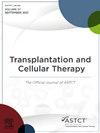Comparison of Nonrelapse Mortality After Haploidentical Hematopoietic Stem Cell Transplantation With Post-transplant Cyclophosphamide Versus Single Umbilical Cord Blood Transplantation in Hematologic Disease
IF 3.6
3区 医学
Q2 HEMATOLOGY
引用次数: 0
Abstract
Unrelated cord blood transplantation (UCBT) and haploidentical transplantation using posttransplant cyclophosphamide (PTCy-haplo) are alternatives for patients lacking a human leukocyte antigen-matched donor. CD34+ cell counts in cord blood affect transplantation outcomes, particularly nonrelapse mortality (NRM). The primary objective of this study was to compare the transplantation outcomes after UCBT and PTCy-haplo focusing on CD34+ cell counts in cord blood. This retrospective study used data from 2014 to 2020 from a Japanese nationwide database. UCBT cases were divided into those with UCBT with higher (UCB-H; ≥.84 × 105/kg) and lower (UCB-L; <.84 × 105/kg) CD34+ cell counts, depending on the median CD34+ cell count. The study cohort comprised cases of PTCy-haplo (n = 1142), UCB-H (n = 3185), and UCB-L (n = 3172). In the multivariate analysis, neutrophil engraftment was significantly better in the PTCy-haplo than in the UCB-H (hazard ratio [HR], .64; 95% confidence interval [CI], .57 to .70; P < .001) and UCB-L groups (HR, .45; 95% CI, .41 to .50; P < .001). The UCB-H group showed similar NRM (HR, 1.19, 95% CI, 1.00 to 1.43, P = .051) and OS (HR, 1.05, 95% CI, .94 to 1.18, P = .38) compared with PTCy-haplo, whereas UCB-L was significantly associated with poor NRM (HR, 1.35, 95% CI, 1.13 to 1.61, P = .001) and OS (HR, 1.13, 95% CI, 1.01 to 1.26, P = .038). In contrast, the UCB-H (HR, .86; 95% CI, .75 to .98; P = .027) and UCB-L groups (HR, .80; 95% CI, .70 to .92; P = .001) were associated with lower relapse rate. Regarding the graft-versus-host disease (GVHD), the UCB-H and UCB-L groups were identified as significant risk factors for the development of grade II–IV acute GVHD (UCB-H: HR, 1.73; 95% CI, 1.51 to 1.99; P < .001; UCB-L: HR, 1.55; 95% CI, 1.35 to 1.78; P < .001) and grade III–IV acute GVHD (UCB-H: HR, 2.28; 95% CI, 1.78 to 2.91; P < .001; UCB-L: HR, 1.85; 95% CI, 1.44 to 2.37; P < .001), but neither were associated with the incidence of all-grade GVHD (UCB-H: HR, 1.12; 95% CI, .95 to 1.32; P = .16; UCB-L: HR, 1.08; 95% CI, .91 to 1.27; P = .37) or extensive chronic GVHD (UCB-H: HR, .86; 95% CI, .68 to 1.09; P = .21; UCB-L: HR, .88; 95% CI, .69 to 1.12; P = .31). Furthermore, higher NRM in UCB-L was attributed to higher infection-related mortality (HR, 1.50; 95% CI, 1.15 to 1.95; P = .003) but not GVHD-related mortality (HR, 1.15; 95% CI, .82 to 1.62; P = .43), whereas UCB-H was not a significant risk factor for both infection-related mortality (HR, 1.29; 95% CI, .99 to 1.69; P = .06) and GVHD-related mortality (HR, 1.28; 95% CI, .90 to 1.80; P = .16). UCB-H offered similar NRM and OS to PTCy-haplo, whereas UCB-L had worse outcomes. Our results can provide useful information for optimal donor selection.
单倍体造血干细胞移植后环磷酰胺与单一脐带血移植治疗血液病后非复发死亡率的比较。
背景:非亲缘脐带血移植(UCBT)和使用移植后环磷酰胺的单倍体移植(PTCy-haplo)是缺乏人类白细胞抗原匹配供体的患者的替代选择。脐带血中的 CD34+ 细胞数量会影响移植结果,尤其是非复发死亡率(NRM):本研究的主要目的是比较 UCBT 和 PTCy-haplo 后的移植结果,重点关注脐带血中的 CD34+ 细胞计数:这项回顾性研究使用了日本全国数据库中 2014 年至 2020 年的数据。根据 CD34+ 细胞计数的中位数,将 UCBT 病例分为 CD34+ 细胞计数较高(UCB-H;≥ 0.84 × 105/kg)和较低(UCB-L;5/kg)的 UCBT 病例:研究队列包括 PTCy-haplo(n = 1,142)、UCB-H(n = 3,185)和 UCB-L(n = 3,172)病例。在多变量分析中,PTCy-haplo 组(危险比 [HR],0.64;95% 置信区间 [CI],0.57-0.70;P <0.001)和 UCB-L 组(HR,0.45;95% 置信区间 [CI],0.41-0.50;P <0.001)的中性粒细胞移植效果明显优于 UCB-H 组(危险比 [HR],0.64;95% 置信区间 [CI],0.57-0.70;P <0.001)。与PTCy-haplo相比,UCB-H组显示出相似的NRM(HR,1.19,95% CI,1.00-1.43,P = 0.051)和OS(HR,1.05,95% CI,0.94-1.18,P = 0.38),而UCB-L则与较差的NRM(HR,1.35,95% CI,1.13-1.61,P = 0.001)和OS(HR,1.13,95% CI,1.01-1.26,P = 0.038)显著相关。相比之下,UCB-H 组(HR,0.86;95% CI,0.75-0.98;P = 0.027)和 UCB-L 组(HR,0.80;95% CI,0.70-0.92;P = 0.001)的复发率较低。关于移植物抗宿主病(GVHD),UCB-H 组和 UCB-L 组被确定为 II-IV 级急性 GVHD(UCB-H:HR,1.73;95% CI,1.51-1.99;P < 0.001;UCB-L:HR,1.55;95% CI,1.35-1.78;P < 0.001)和 III-IV 级急性 GVHD(UCB-H:HR,2.28;95% CI,1.78-2.91;P < 0.001;UCB-L:HR,1.85;95% CI,1.44-2.37;P < 0.001),但两者均与全等级 GVHD 的发生率无关(UCB-H:HR,1.12;95% CI,0.95-1.32;P = 0.16;UCB-L:HR,1.08;95% CI,0.91-1.27;P = 0.37)或广泛慢性 GVHD(UCB-H:HR,0.86;95% CI,0.68-1.09;P = 0.21;UCB-L:HR,0.88;95% CI,0.69-1.12;P = 0.31)。此外,UCB-L 中较高的 NRM 可导致较高的感染相关死亡率(HR,1.50;95% CI,1.15-1.95;P = 0.003),但与 GVHD 相关死亡率无关(HR,1.15;95% CI,0.82-1.62;P = 0.43),而UCB-H不是感染相关死亡率(HR,1.29;95% CI,0.99-1.69;P = 0.06)和GVHD相关死亡率(HR,1.28;95% CI,0.90-1.80;P = 0.16)的显著风险因素:结论:UCB-H的NRM和OS与PTCy-haplo相似,而UCB-L的结果更差。我们的结果可为最佳供体选择提供有用信息。
本文章由计算机程序翻译,如有差异,请以英文原文为准。
求助全文
约1分钟内获得全文
求助全文
来源期刊

Transplantation and Cellular Therapy
Medicine-Hematology
CiteScore
7.00
自引率
15.60%
发文量
1061
审稿时长
51 days
 求助内容:
求助内容: 应助结果提醒方式:
应助结果提醒方式:


